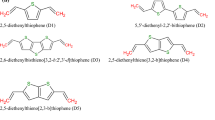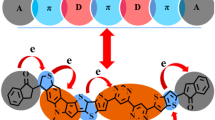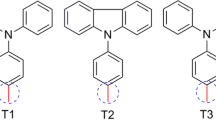Abstract
In this investigation, the new organic dyes (TDBR1–TDBR6) have been designed from a moiety, namely thienobenzodithiophene (TDB), using the density functional theory (DFT) approach. The dyes were analyzed to predict their absorption spectra (λmax), optimized geometries, optical features, density of states, electrostatic potential surfaces with solar cell parameters. It was determined that how electron-donating and electron-withdrawing groups could be affixed with molecules to affect their charge transfer (CT) as a Pull–Push phenomenon. All the new dyes demonstrated a significant Pull–Push effect having maximum absorbance (λmax) 677–691 nm. Furthermore, the analysis of their bond lengths with respect to their planarity patterns indicated a facile CT patterns. All the new dyes also possessed higher LUMO energies (ELUMO) than TiO2 oxide conduction band while they have binding energy (Eb) range of 0.20–0.54 eV. The linear polarizability (< α >) values for all the designed dyes were recorded to be 0.77–1.87 × 10–21 e.s.u, while their first-order polarizability (βtot) and second-order hyperpolarizability (γtot) were ranged to be 2.21–3.81 × 10–25 and 13.8–29.3 × 10–30 esu. Also their computed dipole moments (µtot) were in accordance with their NLO responses having their ranges (0.14–7.65 D). The global reactivity parameters had a direct relationship with NLO qualities. They showed their ionization potential values to 0.63–1.87 eV while their softness values (σ) 0.18–1.08 eV. The higher NLO parameters were seen with a reduction in HOMO–LUMO gaps (HLG) which stated that a dye molecule with a lower HLG value might supposed their global reactivity to be softer, less stable, and much more reactive. Their light harvesting efficiency (LHE), with TDB as donor material, was also very promising (−2.8–1.24) having an ON state for dyes TDBR3–TDBR6. Finally, before synthesis, determining material characteristics using DFT will aid in understanding their projected behavior for their applications like NLO and/or as organic dyes.















Similar content being viewed by others
Data availability
All data generated or analyzed during this study are included in this published article and its supplementary information file.
References
Aal SA, Awadh D (2022) The effect of anchoring group on the performances of metal-free phthalocyanine and metallophthalocyanine Dye/titanium dioxide interface for dye-sensitized solar cells. Surf Interf 32:10208. https://doi.org/10.1016/j.surfin.2022.102089
Abe R, Shinmei K, Koumura N, Hara K, Ohtani B (2013) Visible-light-induced water splitting based on two-step photoexcitation between Dye-sensitized layered niobate and tungsten oxide photocatalysts in the presence of a triiodide/iodide shuttle redox mediator. J Ame Chem Soc 135:16872–16884. https://doi.org/10.1021/ja4048637
Al-Shahri OA, Ismail FB, Hannan MA, Lipu MSH, Al-Shetwi AQ, Begum RA, Al-Muhsen NFO, Soujeri E (2021) Solar photovoltaic energy optimization methods, challenges and issues: a comprehensive review. J Clean Prod 284:125465. https://doi.org/10.1016/j.jclepro.2020.125465
Ayare NN, Sharma S, Sonigara KK, Prasad J, Soni SS, Sekar N (2020) Synthesis and computational study of coumarin thiophene-based D-π-A azo bridge colorants for DSSC and NLOphoric application. J Photochem Photobiol A 394:112466–112516. https://doi.org/10.1016/j.jphotochem.2020.112466
Bagchi D, Chaudhuri S, Sardar S, Choudhury S, Polley N, Lemmens P, Pal SK (2015) Modulation of stability and functionality of a phyto-antioxidant by weakly interacting metal ions: curcumin in aqueous solution. RSC Adv 5:102516–102524. https://doi.org/10.1039/C5RA21593E
Belviso S, Santoro E, Penconi M, Righetto S, Tessore F (2019) Thioethyl porphyrazines: Attractive chromophores for second-order nonlinear optics and DSSCs. J Phys Chem C 123:13074–13082. https://doi.org/10.1021/acs.jpcc.9b02654
Britel O, Fitri A, Touimi Benjelloun A, Slimi A, Benzakour M, Mcharfi M (2022) Theoretical design of new carbazole based organic dyes for DSSCs applications A DFT/TD-DFT insight. J Photochem Photobiol A 429:113902–113916. https://doi.org/10.1016/j.jphotochem.2022.113902
Del Bene JE, Person WB, Szczepaniak K (1995) Properties of hydrogen-bonded complexes obtained from the B3LYP functional with 6–31G(d, p) and 6–31+G(d, p) basis sets: comparison with MP2/6–31+G(d, p) results and experimental data. J Phy Chem 99:10705–10707. https://doi.org/10.1021/j100027a005
Dindorkar SS, Yadav A (2022) Insights from density functional theory on the feasibility of modified reactive Dyes as Dye sensitizers in Dye-sensitized solar cell. Appl Solar 2:12–31. https://doi.org/10.3390/solar2010002
Dubey RP, Patel UH, Patel BD (2018) Study on molecular structure, Spectral investigations, NBO, NLO, Hirshfeld surface analysis and Homo-Lumo energy of silver complex of 4-Amino-N-(2,6-dimethoxypyrimidin-4-yl)benzenesulfonamide. Inorg Nano-Metal Chem 48:110–119. https://doi.org/10.1080/24701556.2017.1357635
Duerto I, Sarasa S, Barrios D, Orduna J, Villacampa B, Blesa M-J (2022) Enhancing the temporal stability of DSSCs with novel vinylpyrimidine anchoring and accepting group. Dyes Pig 203:110310. https://doi.org/10.1016/j.dyepig.2022.110310
Etabti H, Fitri A, Benjelloun AT, Hachi M, Benzakour M, Mcharfi M (2021) Benzocarbazole-based D-Di–π–A dyes for DSSCs: DFT/TD-DFT study of influence of auxiliary donors on the performance of free dye and dye–TiO2 interface. Res Chem Inter 47:4257–4280. https://doi.org/10.1007/s11164-021-04531-6
Fan Q, Méndez-Romero UA, Guo X, Wang E, Zhang M, Li Y (2019) Fluorinated photovoltaic materials for high-performance organic solar cells. Chem Asian J 14:3085–3095. https://doi.org/10.1002/asia.201900795
Fan T, Jian L, Huang X, Zhang S, Murtaza I, Abid R, Liu Y, Min Y (2022) Enhanced photocatalytic activity of multifunctional graphene quantum dots decorated TiO2 film for dye-sensitized solar cells. J Mat Sci Mat Elect 33:24048–24058. https://doi.org/10.1007/s10854-022-09023-w
Fantin PA, Barbieri PL, Neto AC, Jorge FE (2007) Augmented Gaussian basis sets of triple and quadruple zeta valence quality for the atoms H and from Li to Ar: applications in HF, MP2, and DFT calculations of molecular dipole moment and dipole (hyper) polarizability. J Mol Struct THEOCHEM 810:103–111. https://doi.org/10.1016/j.theochem.2009.06.024
Frisch JM, Trucks WG, Schlegel BH, et al (2009) Gaussian 09, Revision D. 01, Gauss. Inc, Wallingford CT
Garmire E (2013) Nonlinear optics in daily life Opt. Exp 21:30532–30544. https://doi.org/10.1364/OE.21.030532
Glendening ED, Landis CR, Weinhold F (2012) Natural bond orbital methods. Wiley Interdiscip Rev: Comput Mol Sci 2:1–42. https://doi.org/10.1002/wcms.51
Goetzberger A, Hebling C (2000) Photovoltaic materials, past, present, future. Sol Ener Mat Sol Cells 62:1–19. https://doi.org/10.1016/S0927-0248(99)00131-2
Gopala KJ, Roy K (2022) QSPR modeling of absorption maxima of dyes used in dye sensitized solar cells (DSSCs). Spectrochim Acta Part A 265:120387. https://doi.org/10.1016/j.saa.2021.120387
Goudjil M, Kheffache D, Rekis M (2022) First principle investigation of new dithienosilole-based dyes for DSSCs: effects of auxiliary acceptor groups. Theor Chem Acc 141:72. https://doi.org/10.1007/s00214-022-02933-2
Gounden D, Nombona N, Van Zyl WE (2020) Recent advances in phthalocyanines for chemical sensor, non-linear optics (NLO) and energy storage applications. Coord Chem Rev 420:213359. https://doi.org/10.1016/j.ccr.2020.213359
Guo Y, Zhao J, Dong M, Yu Z, Fu Y, Feng J, Gao H, Wu Y, Jiang L (2022) Strong in-plane anisotropy and giant second harmonic generation response of organic single-crystalline microwire arrays. Adv Op Mat 10:220070. https://doi.org/10.1002/adom.202200701
Hanwell MD, Curtis DE, Lonie DC, Vandermeersch T, Zurek E, Hutchison GR (2012) Avogadro: an advanced semantic chemical editor, visualization, and analysis platform. J Cheminfo 4:17. https://doi.org/10.1186/1758-2946-4-17
Haroon M, Janjua MRSA (2022) Exploring the effect of end-capped modifications of carbazole-based fullerene-free acceptor molecules for high-performance indoor organic solar cell applications. J Comput Elec 21:40–51. https://doi.org/10.1007/s10825-021-01838-w
Hassan AU, Sumrra SH, Mustafa G, Nazar MF, Zafar MN (2022a) Efficient and tunable enhancement of NLO performance for indaceno-based donor moiety in A-π-D-π-D-π-A type first DSSC design by end-capped acceptors. J Mol Mod 29:4. https://doi.org/10.1007/s00894-022-05402-6
Hassan AU, Sumrra SH, Mustafa G, Zubair M, Mohyuddin A, Nkungli NK, Imran M (2023) Molecular modeling of mordant black dye for future applications as visible light harvesting materials with anchors: design and excited state dynamics. J Mol Model 29:74. https://doi.org/10.1007/s00894-023-05474-y
Hassan AU, Sumrra SH (2022) Exploration of pull-push effect for novel photovoltaic Dyes with A–π–D design: a DFT/TD-DFT investigation. J Fluoresc. https://doi.org/10.1007/s10895-022-03003-3
Hassan AU, Sumrra SH, Raza MA, Zubair M, Zafar MN, Mughal EU, Nazar MF, Irfan A, Imran M, Assiri MA (2020) Design, facile synthesis, spectroscopic characterization, and medicinal probing of metal-based new sulfonamide drugs: a theoretical and spectral study. App Organomet Chem 35:e6054. https://doi.org/10.1002/aoc.6054
Hassan AU, Sumrra SH, Nkungli NK, Güleryüz C (2022b) Theoretical probing of 3d nano metallic clusters as next generation non-linear optical materials. Res Chem 4:100627. https://doi.org/10.1016/j.rechem.2022.100627
Huang S, Shao W, Shi S, Kong X, Wang G, Hu Z, Wu W, Tan H (2022) The effect of conjugated groups for favourable molecular planarity and efficient suppression of charge recombination simultaneously of phenothiazine-based organic dyes for dye-sensitized solar cells. Synt Met 290:117137. https://doi.org/10.1016/j.synthmet.2022.117137
Komjáti B, Urai Á, Hosztafi S, Kökösi J, Kováts B, Nagy J, Horváth P (2016) Systematic study on the TD-DFT calculated electronic circular dichroism spectra of chiral aromatic nitro compounds: a comparison of B3LYP and CAM-B3LYP. Spectrochim Acta A 155:95–102. https://doi.org/10.1016/j.saa.2015.11.002
Listorti A, O’Regan B, Durrant JR (2011) Electron transfer dynamics in dye-sensitized solar cells. Chem Mat 23:3381–3399. https://doi.org/10.1021/cm200651e
Luo J, Xue ZQ, Liu WM, Wu JL, Yang ZQ (2006) Koopmans’ theorem for large molecular systems within density functional theory. J Phys Chem A 110:12005–12009. https://doi.org/10.1021/JP063669M
Mikael J (1994) Summary: B3LYP. Phys Rev 99:6–9
Miki K, Enomoto A, Inoue T, Nabeshima T, Saino S, Shimizu S, Matsuoka H, Ohe K (2017) Polymeric self-assemblies with boron-containing near-infrared dye dimers for photoacoustic imaging probes. Biomacromol 18:249–256. https://doi.org/10.1021/acs.biomac.6b01568
Moroz A (1995) Density-of-states calculations and multiple-scattering theory for photons. Phys Rev B 51:2068. https://doi.org/10.1103/PhysRevB.51.2068
Muruganandi G, Raj MBJ (2019) Second and third-order NLO response of 2-amino-5-nitropyridinium tetrafluoroborate. Optik 182:755–760. https://doi.org/10.1016/j.ijleo.2019.01.110
Nosheen E, Shah SM, Hussain H, Murtaza G (2016) Photo-sensitization of ZnS nanoparticles with renowned ruthenium dyes N3, N719 and Z907 for application in solid state dye sensitized solar cells: a comparative study. J Photochem Photob B 162:583–591. https://doi.org/10.1016/j.jphotobiol.2016.07.033
Patel DG, Bastianon NM, Tongwa P, Leger JM, Timofeeva TV, Bartholomew GP (2011) Modification of nonlinear optical dyes for dye sensitized solar cells: a new use for a familiar acceptor. J Mater Chem 21:4242–4250. https://doi.org/10.1039/C0JM03774E
Patil DS, Avhad KC, Sekar N (2018) Linear correlation between DSSC efficiency, intramolecular charge transfer characteristics, and NLO properties–DFT approach. Comput Theor Chem 1138:75–83. https://doi.org/10.1016/j.comptc.2018.06.006
Peng X, Yang Z, Wang J, Fan J, He Y, Song F, Wang B, Sun S, Qu J, Qi J, Yan M (2011) Fluorescence ratiometry and fluorescence lifetime imaging: using a single molecular sensor for dual mode imaging of cellular viscosity. J Am Chem Soc 133:6626–6635. https://doi.org/10.1021/ja1104014
Qin S, Lu C, Jia Z, Wang Y, Li S, Lai W, Shi P, Wang R, Zhu C, Du J (2022) Constructing monolithic perovskite/organic tandem solar cell with efficiency of 22.0% via reduced open-circuit voltage loss and broadened absorption spectra. Adv Mat 34:2108829. https://doi.org/10.1002/adma.202108829
Rabaia MKH, Abdelkareem MA, Sayed ET, Elsaid K, Chae K-J, Wilberforce T, Olabi AG (2021) Environmental impacts of solar energy systems: a review. Sci Tot Env 754:141989. https://doi.org/10.1016/j.scitotenv.2020.141989
Ren S, Hao Y, Xu L, Wu H, Ba N (2021) Digitalization and energy: how does internet development affect China’s energy consumption? Ener Eco 98:105220. https://doi.org/10.1016/j.eneco.2021.105220
Reynal A, Palomares E (2011) Ruthenium Polypyridyl Sensitisers in dye solar cells based on mesoporous TiO2. European J Inorg Chem 2011:4509–4526. https://doi.org/10.1002/ejic.201100516
Shahsavari A, Akbari M (2018) Potential of solar energy in developing countries for reducing energy-related emissions. Ren Sust Ener Rev 90:275–291. https://doi.org/10.1016/j.rser.2018.03.065
Shanmuga Sundar GJ, Ravi Kumar SM, Sagayaraj P, Selvakumar S, Shanthi C, Sivaraj S, Gunaseelan R (2021) Structural, mechanical, thermal, electrical, second-and third-order nonlinear optical characteristics of MCBT NLO crystal for optoelectronics device and laser applications. Bull Mat Sci 44:1–8. https://doi.org/10.1007/s12034-021-02491-6
Shi A, Li H, Yin S, Liu B, Zhang J, Wang Y (2017) Effect of conjugation degree and delocalized π-system on the photocatalytic activity of single layer g-C3N4. Appl Catal B 218:137–146. https://doi.org/10.1016/j.apcatb.2017.06.017
Solimannejad M, Rahimi R, Kamalinahad S (2017) Nonlinear optical (NLO) response of Si12C12 nanocage decorated with alkali metals (M = Li, Na and K): a theoretical study. J Inorg Organomet Polym 27:1234–1242. https://doi.org/10.1007/s10904-017-0570-4
Song X, Yang X, Wang H, An J, Yu Z, Wang X, Hagfeldt A, Sun L (2019) Improving energy transfer efficiency of dye-sensitized solar cell by fine tuning of dye planarity. Sol Ener 187:274–280. https://doi.org/10.1016/j.solener.2019.05.053
Sosorev AYu, Trukhanov VA, Maslennikov DR, Borshchev OV, Polyakov RA, Skorotetcky MS, Surin NM, Kazantsev MS, Dominskiy DI, Tafeenko VA, Ponomarenko SA, Paraschuk DYu (2020) Fluorinated Thiophene-Phenylene co-oligomers for optoelectronic devices. ACS Appl Mater Interf 12:9507–9519. https://doi.org/10.1021/acsami.9b20295
Su’aitRahmanAhmad MSMYAA (2015) Review on polymer electrolyte in dye-sensitized solar cells (DSSCs). Sol Ener 115:452–470. https://doi.org/10.1016/j.solener.2015.02.043
Sudarsan V (2012) Optical materials: fundamentals and applications. Func Mat. https://doi.org/10.1016/B978-0-12-385142-0.00008-8
Sumrra SH, Hassan AU, Imran M, Khalid M, Mughal EU, Zafar MN, Tahir MN, Raza MA, Braga AAC (2020) Synthesis, characterization, and biological screening of metal complexes of novel sulfonamide derivatives: experimental and theoretical analysis of sulfonamide crystal. Appl Organom Chem 34:e5623. https://doi.org/10.1002/aoc.5623
Sumrra SH, Arshad Z, Zafar W, Mahmood K, Ashfaq M, Hassan AU, Mughal EU, Irfan A, Imran M (2022a) Metal incorporated aminothiazole-derived compounds: synthesis, density function theory analysis, in vitro antibacterial and antioxidant evaluation. Royal Soc Op Sci 8:210910. https://doi.org/10.1098/rsos.210910
Sumrra SH, Hassan AU, Zafar MN, Shafqat SS, Mustafa G, Zafar MN, Zubair M, Imran M (2022b) Metal incorporated sulfonamides as promising multidrug targets: combined enzyme inhibitory, antimicrobial, antioxidant and theoretical exploration. J Mol Struc 1250:131710. https://doi.org/10.1016/j.molstruc.2021.131710
Tae EL, Lee SH, Lee JK, Yoo SS, Kang EJ, Yoon KB (2005) A strategy to increase the efficiency of the dye-sensitized TiO2 solar cells operated by photoexcitation of Dye-to-TiO2 charge-transfer bands. J Phys Chem B 109:22513–22522. https://doi.org/10.1021/jp0537411
Wang H, Ye J, Qiu Y, Chen F (2022) Theoretical investigation of electronic structures, second-order NLO responses of cyclometalated Ir(III) and Rh(III) counterpart complexes: effect of metal centers. New J Chem 46:10652–10661. https://doi.org/10.1039/D2NJ01659A
Wazzan N, Irfan A (2018) Theoretical study of triphenylamine-based organic dyes with mono, di, and tri-anchoring groups for dye-sensitized solar cells. Org Elect 63:328–342. https://doi.org/10.1016/j.orgel.2018.09.039
Wei LI, Xie H, Huang Y, Song L, Shao Y, Qiu K (2016) Application of Gaussian 09/GaussView 5.0 in analytical chemistry teaching. J Kun MedUni 37:134–136
Yadav V, Chaudhary S, Negi CMS, Gupta SK (2020) Textile dyes as photo-sensitizer in the dye sensitized solar cells. Optical Mater 109:110306. https://doi.org/10.1016/j.optmat.2020.110306
Zhang J, Li H-B, Sun S-L, Geng Y, Wu Y, Su Z-M (2012) Density functional theory characterization and design of high-performance diarylamine-fluorene dyes with different π spacers for dye-sensitized solar cells. J Mat Chem 22:568–576. https://doi.org/10.1039/C1JM13028E
Zhurko GA, Zhurko DA (2009) ChemCraft, version 1.6. URL: http://www.chemcraftprog.com.
Acknowledgements
The authors are grateful to the University of Gujrat, Gujrat, Pakistan, for accessing the all-research facilities. MI extends his appreciation to the Deanship of Scientific Research at King Khalid University for funding this work through small Group Research Project under grant number RGP-1/92/43.
Funding
The authors declare that no funds, grants, or other support were received during the preparation of this manuscript.
Author information
Authors and Affiliations
Contributions
SHS contributed to conceptualization; AUH contributed to methodology; MZ contributed to formal analysis and investigation; SN contributed to writing-original draft preparation; GM contributed to writing-review and editing; and MI contributed to resources.
Corresponding authors
Ethics declarations
Conflict of interest
The authors have no competing interests to declare that are relevant to the content of this article.
Code availability
Gaussian 09 W and Gauss view 5.1 are used for simulation, and origin software is used to draw the plots.
Human and animal rights
This work did not involve any human subjects.
Consent to participate
This article does not contain any studies with human participants or animals, clinical trial registration, or plant reproducibility performed by any author.
Consent for publication
All authors have approved the paper and agree with its publication.
Additional information
Publisher's Note
Springer Nature remains neutral with regard to jurisdictional claims in published maps and institutional affiliations.
Supplementary Information
Below is the link to the electronic supplementary material.
Rights and permissions
Springer Nature or its licensor (e.g. a society or other partner) holds exclusive rights to this article under a publishing agreement with the author(s) or other rightsholder(s); author self-archiving of the accepted manuscript version of this article is solely governed by the terms of such publishing agreement and applicable law.
About this article
Cite this article
Hassan, A.U., Sumrra, S.H., Zubair, M. et al. Correlating the charge density and structural fabrication of new organic dyes to create visible light harvesting materials with tunable NLO refining: insights from DFT. Chem. Pap. 77, 6183–6202 (2023). https://doi.org/10.1007/s11696-023-02931-z
Received:
Accepted:
Published:
Issue Date:
DOI: https://doi.org/10.1007/s11696-023-02931-z




